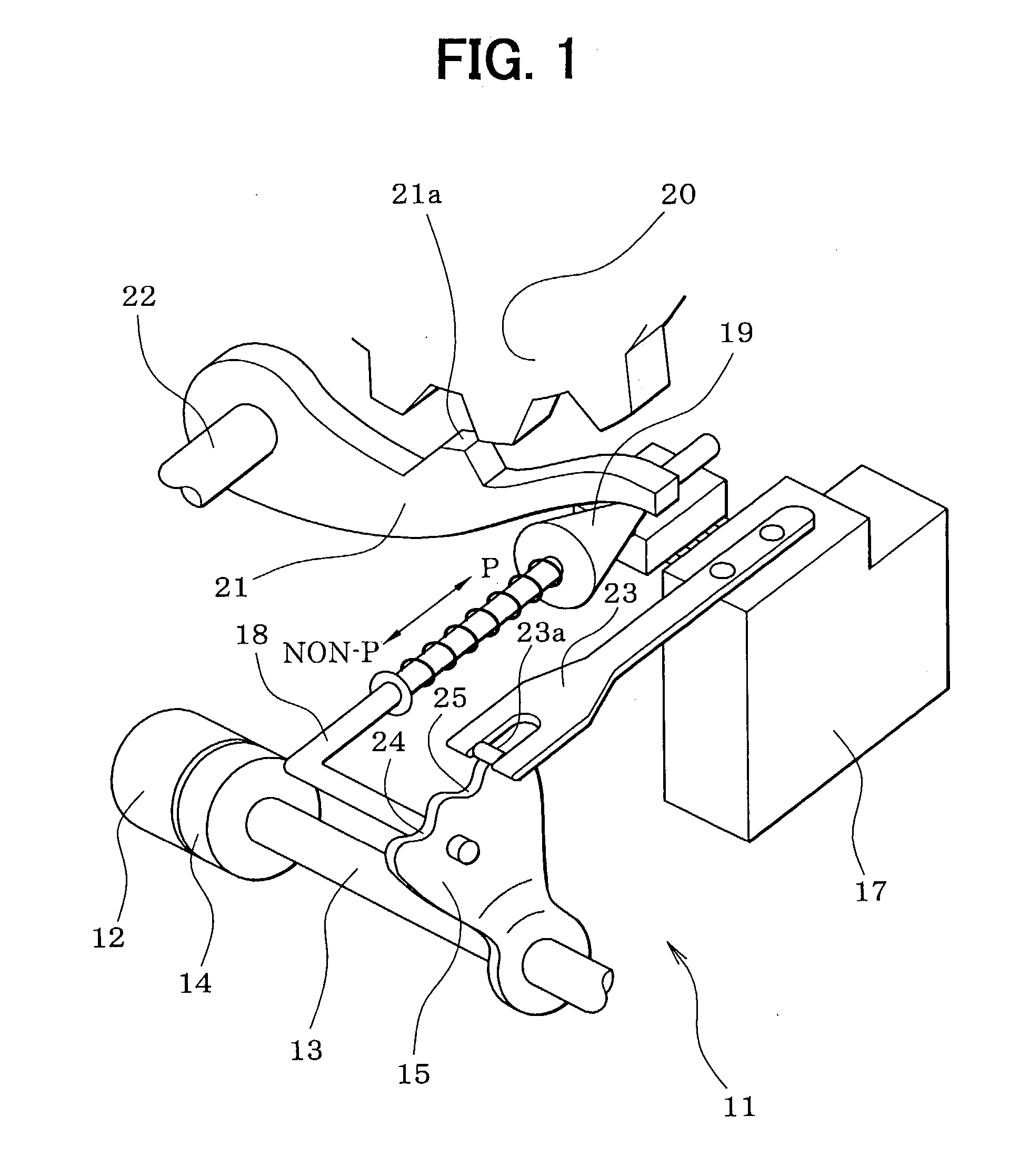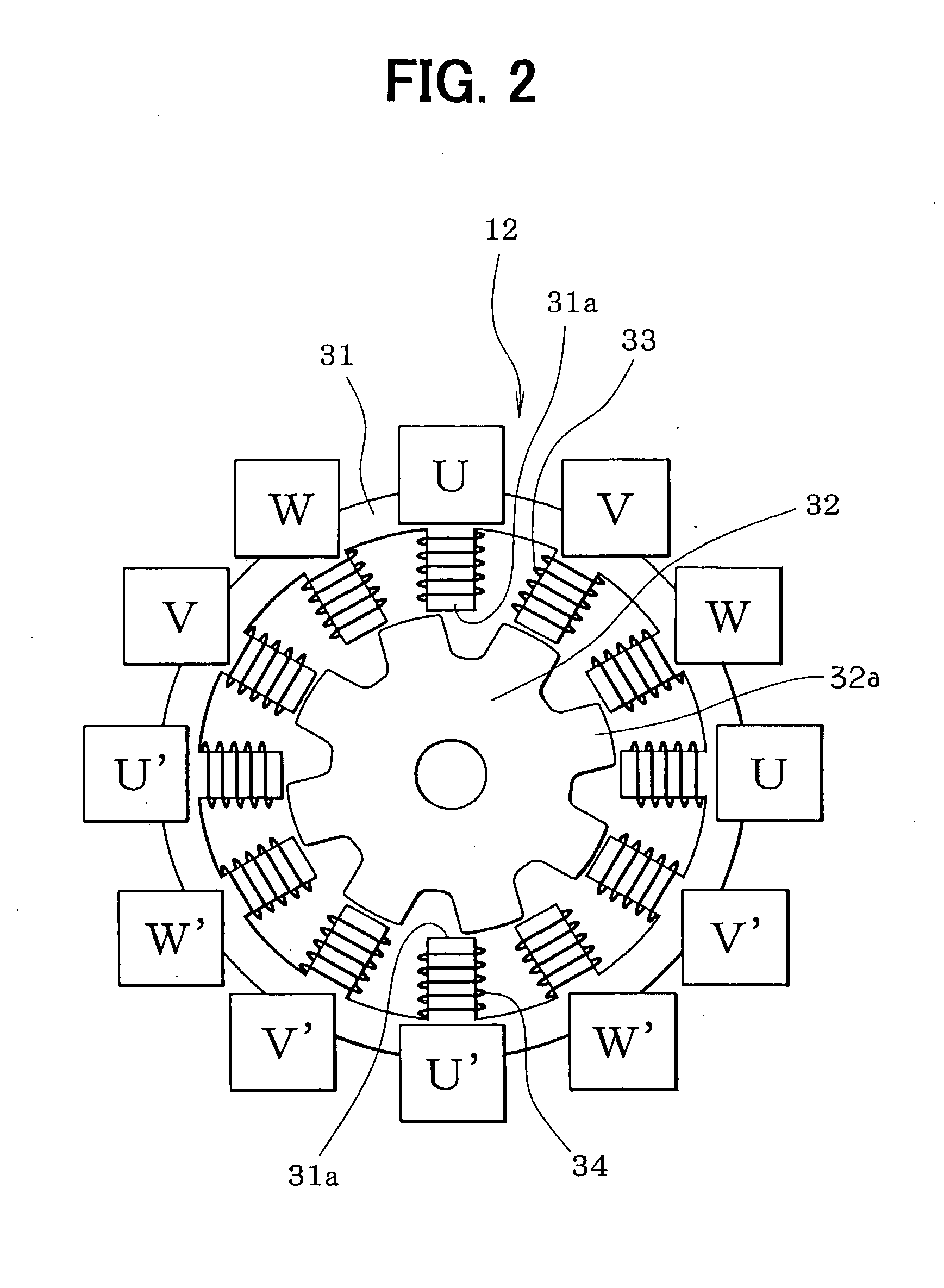Motor control apparatus
a motor control and motor technology, applied in the direction of program control, dynamo-electric converter control, instruments, etc., can solve the problems of motor uncontrollability, motor cannot be driven normally, motor cannot continue normal feedback control, etc., to reduce driving torque, reduce motor size, and increase reliability
- Summary
- Abstract
- Description
- Claims
- Application Information
AI Technical Summary
Benefits of technology
Problems solved by technology
Method used
Image
Examples
first embodiment
[0090] A first embodiment in which the present invention is applied to a position switching device of a vehicle will be hereinafter described with reference to FIGS. 1-48.
[0091] First, the configuration of a position switching mechanism 11 will be described with reference to FIG. 1. A motor 12 as a drive source of the position switching mechanism 11 is a switched reluctance motor, for example, incorporates a speed-reducing mechanism 26 (see FIG. 4), and is equipped with an output shaft sensor 14 for detecting a rotation position of the output shaft 13 of the speed-reducing mechanism 26. A detent lever 15 is fixed to the output shaft 13.
[0092] An L-shaped parking rod 18 is fixed to the detent lever 15. A conical body 19 that is provided at the tip of the parking rod 18 is in contact with a lock lever 21. The lock lever 21 is moved in the vertical direction in accordance with the position of the conical body 19 and thereby locks or unlocks a parking gear 20. The parking gear 20 is att...
second embodiment
[0505] A second embodiment of the invention will be described below with reference to FIGS. 71-75.
[0506] As shown in FIG. 72, while the SR motor 12 rotates, A-phase signal pulses and B-phase signal pulses are output alternately from the encoder 46 in synchronism with the rotation of the rotor 32 and a Z-phase signal pulse is output from the encoder 46 every time current supply is effected for all the phases around and the rotor 32 rotates by 45.degree.. The reference rotation positions of the rotor 32 can be detected correctly by using Z-phase signal pulses. Therefore, whether the rotation position of the rotor 32 and the current supply phase (i.e., encoder count) are in a correct relationship can be checked by determining whether a current supply phase (i.e., an encoder count) that is selected when a Z-phase signal pulse is output coincides with a current supply phase (i.e., an encoder count) corresponding to a reference rotation position of the rotor 32. If a deviation is found, a...
third embodiment
[0555] A third embodiment of the invention will be described below with reference to FIGS. 76-81.
[0556] [Open-Loop Control]
[0557] An open-loop control routine shown in FIGS. 76-78 is activated every predetermined time (e.g., every 1 ms). Upon activation of this routine, at step 3931, it is determined whether the open-loop control execution flag Xopen is "on." If the flag Xopen is "off," this routine is finished without executing the remaining steps.
[0558] On the other hand, if the open-loop control execution flag Xopen is "on," the routine proceeds from step 3931 to step 3932, where the count Top of a time counter that counts time is incremented. At the next step 3933, it is determined whether the count Top of the time counter has become greater than or equal to a current supply time tm of a current supply phase. If the time count Top is smaller than the current supply time tm, this routine is finished without executing the remaining steps. With this measure, step 3934 and the follo...
PUM
 Login to View More
Login to View More Abstract
Description
Claims
Application Information
 Login to View More
Login to View More - R&D
- Intellectual Property
- Life Sciences
- Materials
- Tech Scout
- Unparalleled Data Quality
- Higher Quality Content
- 60% Fewer Hallucinations
Browse by: Latest US Patents, China's latest patents, Technical Efficacy Thesaurus, Application Domain, Technology Topic, Popular Technical Reports.
© 2025 PatSnap. All rights reserved.Legal|Privacy policy|Modern Slavery Act Transparency Statement|Sitemap|About US| Contact US: help@patsnap.com



